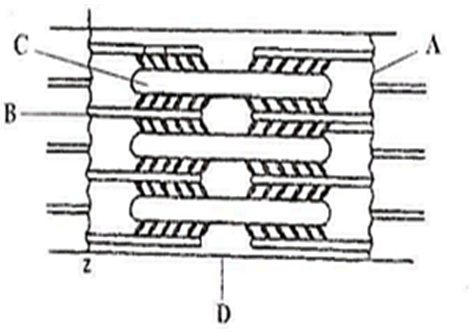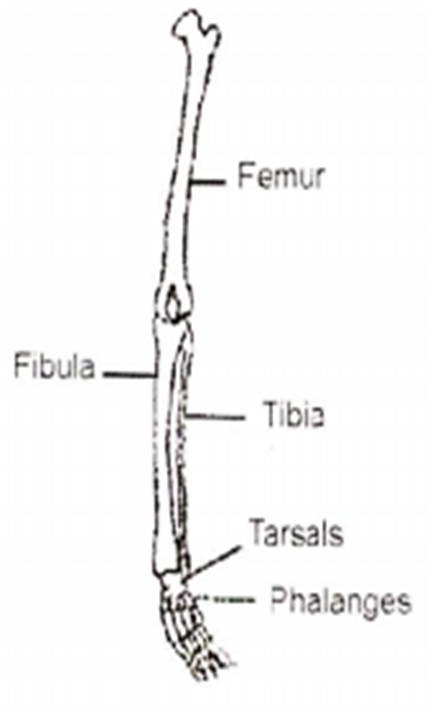 Multiple Choice Questions
Multiple Choice QuestionsAssertion: In a pivot joint, rounded or pointed bone fits into a shallow depression in another bone.
Reason: Pivot joints are present between the metacarpals and phalanges of the fingers.
If both assertion and reason are true and reason is the correct explanation of assertion.
If both assertion and reason are true but reason is not the correct explanation of assertion.
If assertion is true but reason is false.
If both assertion and reason are false.
During muscular contraction, which of the following events occur
(i) H-zone disappears
(ii) A band widens
(iii) I band reduces in width
(iv) Width of A band is unaffected
(v) M line and Z line come closer
(i), (iii), (iv) and (v)
(i), (i) and (v)
(ii), (iv) and (v)
(i), (ii) and (iii)
Which of the following is true for the labelled parts in the figure below?

A - Z- line - located at centre of I - band
B - Thin filament - occurs in A- band only
C - Thick filament - confined to I- band
D - H- zone - located at centre of M - Line
Which of the following is correct about the given figure?

The length ofthe thick and thin myofilaments has changed.
Length of both anisotropic and isotropic band has changed.
The myosin cross-bridges move on the surface of actin and the thin and thick myofilaments slide past each other.
Length of the sarcomere remains same.
What is diapedesis?
A kind of amoeboid movement.
The process of filtration of urea in kidney.
A type of locomotion found in Hydra
Migration of WBCs into the tissue spaces from blood capillaries
Skeletal muscles appear striated due to presence of two characteristic proteins in alternating dark and light bands. Which of the following is a correct match of the protein with its light refractive property and colour
| Protien | Colour | Property |
| Myosin | Light | Anisotropic |
| Actin | Dark | Anisotropic |
| Myosin | Dark | Isotropic |
| Actin | Light | Isotropic |
A cricket player is fast chasing a ball in the field. Which one of the following groups of bones are directly contributing in this movement
Femur, malleus, tibia, metatarsals
Pelvis, ulna, patella, tarsals
Sternum, femur, tibia, fibula
Tarsals, femur, metatarsals, tibia
D.
Tarsals, femur, metatarsals, tibia
Tarsal- Tarsal, any of several short, angular bones that in humans make up the ankle and that—in animals that walk on their toes (e.g., dogs, cats) or on hoofs—are contained in the hock, lifted off the ground. The tarsals correspond to the carpal bones of the upper limb.
Femur- Femur, also called thighbone, or hind leg. The head forms a ball and socket with the hip (at the acetabulum), being held in place by a ligament (ligamentum teres femoris) within the socket and by strong surrounding ligaments.
Metatarsals- Anatomical terms of bone. The metatarsal bones, or metatarsus are a group of five long bones in the foot, located between the tarsal bones of the hind- and mid-foot and the phalanges of the toes
Tibia- The tibia, also known as the shinbone or shankbone, is the larger, stronger, and anterior (frontal) of the two bones in the leg below the knee in vertiberates (the other being the fibula, behind and to the outside of the tibia), and it connects the knee with the ankle bones.
Given diagram shows bone of the left human hindlimb as seen from front. It has certain mistakes in labeling. Two of the wrongly labelled bones are

tibia and tarsals
femur and fibula
fibula and phalanges
tarsals and femur
